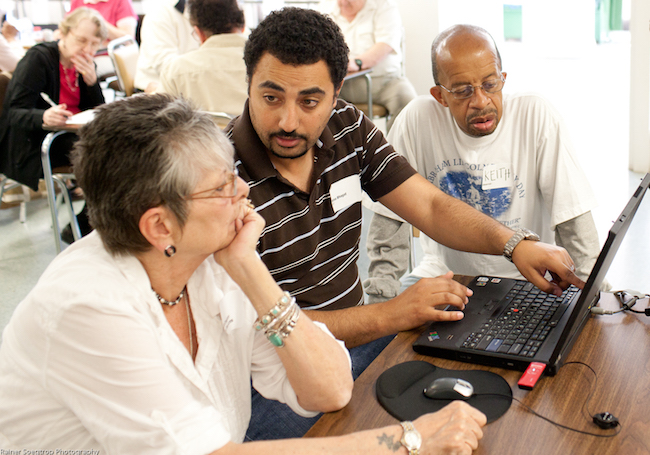Placing accessibility considerations at the beginning and center of a design process does more than include additional people — the end result is clearer design, more people’s ideas, and an improved end product.
Equity means bringing many types of people to a place of equal power to contribute and participate. When we ensure that our concept of equity includes people who may need physical support — for example, to get into a room or read information on a web page — we’re taking more people into consideration.
Read on to learn about how PBP has leveraged user interviews and best practices in aaccessibility fordigital and in-person event design in our work. Two experts from a recent panel also share crucial tips on civic user testing and access equity.
THINK ABOUT IT
Anna’s daughter gets out of daycare at 5:45, and the meeting starts at 7:00. She doesn’t see anything about childcare on the flyer, and worries she’d have to drag the stroller up the stairs anyway. She doesn’t go. As it turns out, the location had both an elevator and childcare — it’s just that neither were mentioned in every ad for the event.
Charon reads her email using a tool called a screen reader, and the emails she gets from her city councilor are usually pretty good — except it seems recently someone started including pictures to share the date and time of events instead of in the email text. Since the screen reader can’t “read” text information that is only in pictures, Charon misses being able to share her ideas — large-print bus signs!
Edwin is an accomplished writer in his first language but is more fluent in spoken than written English, his second language. When he gets the digital ballot to vote in PB, the projects are translated ok but the buttons and checkboxes are a bit confusing. Which one means “Vote?” Edwin gets help to finish voting, but decides not to do that again.
What do these have in common?
These are accessibility issues which could be addressed using a few human-centered design principles.
SOLUTION DESIGN
These are three things you can do to design solutions to needs that arise around accessibility into your work.
- Include accessibility early. Include accessibility considerations as part of design and planning. Some people leading PB have accessibility committees or focuses in the steering committee, and I think it makes sense to think about this early in the process.
Whitney Quesenbury, in a recent presentation, drew a distinction between ADA accessibility for people with disabilities and access-ability — giving people access across barriers: with that distinction, it’s crucial we who work in the civic realm be both accurate and comprehensive when we speak about accessibility.
- Ask questions of the people you want using your thing or participating in your event.
Lawrence Grodeska of CivicMakers described including a Civic User Testing group as a way to get feedback along the way, ensuring more user perspectives are considered. This alone can help address issues of techno
The Center for Civic Design implemented a ballot study for PBNYC in 2016, which meant watching and listening to people as they used a pilot digital ballot. The result? The launch of the digital ballot in 2017 lead to over a 50% increase in voting with 35,000 ballots cast digitally.
- Draw on established best practices for each format:
- ON YOUR WEBSITE: The Web company 18F has designed for the US Government for over 10 years and has developed accessibility standards for the web. They observe, “When the American people go online to access government services, they’re often met with confusing navigation systems, a cacophony of visual brands, and inconsistent interaction patterns.” — 18F, US Web Design Standards
- IN-PERSON SPACE: Bring up access needs in meetings, in online promotions. Point out if a meeting space has stairs, if there is childcare or not, if there are translators or ASL interpreters or not. Give people the power to decide how access will work for them, rather than leaving questions hanging.
- DIGITAL SHARING: The internet and email are built on text, which people who use tools to get information off the web can work with. However, when non-text items are included, like images or some PDFs — Houston we have a problem!As Whitney points out here, some word processing software, when creating PDFs, don’t make them so the text can be read by screen readers. Your solution? For images, include “alt text” that includes a description of the image and any pertinent details like dates or times in the image. For PDFs, it’s definitely OK to use them as long as they can be “scraped”. To check: can your cursor “swoop” across it and gather text to copy? You’re probably set, and it’s always worth checking!

Make accessibility the rule
When we consider and mention accessibility criteria as a normal part and parcel of our work, then we make room for people with accessibility needs to be the determinants if they’ll join at the table, meeting room, or online space just by the act of consideration
Talking about accessibility = Thinking about accessibility.
Creating inviting, participatory work — both online and in person — means including people. The more regular and every day it is to talk about
Seek external leadership if you need help. If you don’t know a lot about accessibility, there are many brilliant people providing thought leadership, helpful guides, and urges to create more accessible physical and digital spaces. A few of these include:
- The Radical Access Mapping Project
- Explore disability justice as a search term – start with this site.
What’s an example of great accessibility communications that you’ve seen? Comment on the post and/or reply to the tweet to let us know where leadership is already happening!




